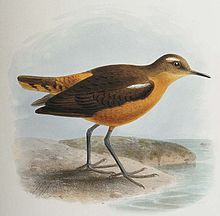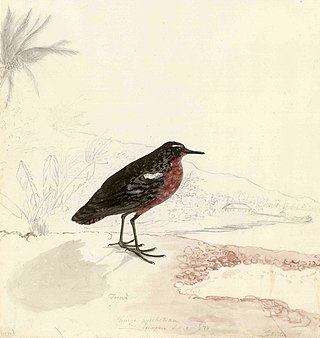Description
The Tuamotu sandpiper, P. parvirostris, is a unique short-billed all-brown wader previously found over a large area of the Pacific, but now confined to a few islands in the Tuamotu archipelago and still declining. Its decline appears to be due to human habitation encroachment and introduced mammals. It feeds on insects, but takes some vegetable material from its coastal haunts. It nests on the ground, and has a soft piping call.
The extinct Tahiti sandpiper, P. leucoptera of Tahiti was similar in size and shape to P. cancellata. It had brown upperparts, reddish underparts, a white wingbar, and some white on the face and throat. It became extinct in the 19th century, and little is known of it.
There was a similar bird on Moorea which differed in some minor details from P. leucoptera, notably the larger extent of white in the wing, and has been described as Moorea sandpiper (P. ellisi). However, although two species are generally listed, the question whether they actually did constitute separate species is probably unresolvable as only a single specimen of it exists today, apart from some contemporary paintings.
From Mangaia in the Cook Islands, Ua Huka in the Marquesas, and the remote South Pacific Henderson Island [6] subfossil remains of Prosobonia have been recovered but not yet named. The first of these was almost certainly more closely related to the Tahiti and Moorea populations than to the Tuamotu sandpiper, but the exact nature of their relationship is unlikely to be resolved anytime soon. It disappeared in the early-mid 1st millennium AD, probably not long after 300 AD.
The Ua Huka and Henderson forms can be assumed to have been closer to the living species. The latter, a distinct species with long legs and short wings, [7] became extinct only about 1000 years after the Mangaia form, some time after 1200.
In 2020 a new extinct species, Prosobonia sauli was described from specimens found on Henderson Island, part of the Pitcairn Islands. A genetic analysis found that the genus was sister to the clade containing Arenaria and Calidris . [5]
This page is based on this
Wikipedia article Text is available under the
CC BY-SA 4.0 license; additional terms may apply.
Images, videos and audio are available under their respective licenses.












